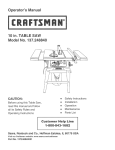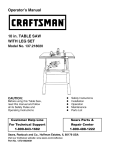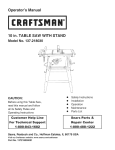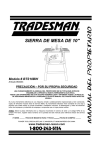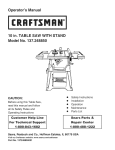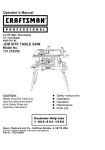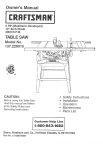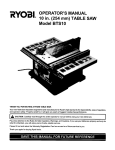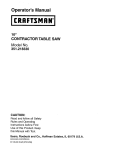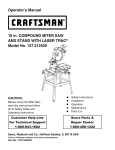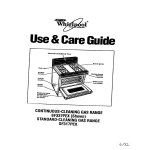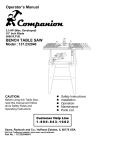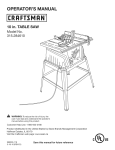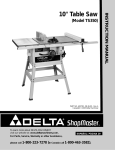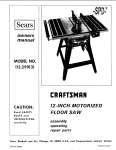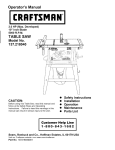Download Craftsman 137.218010 Operating instructions
Transcript
Operator's Manuam m CAUTION: Before using this Table Saw, read this manual and follow all its Safety Rules and Operating Instructions o o Safety Instructions Installation o + o Operation Maintenance Parts List Customer Help Line 1 o800o843ol 682 Sears, Roebuck Visit our Oraftsman and Co., Hoffman website: Part No. 137218010001 Estates, www.sears.com/craftsman IL 60179 USA SECTION PAGE Warranty ........................................................ Product Specifications .................................... Power Tool Safety ........................................... Tabe! Saw Safety ............................................ Electrical Reuirements and Safety .................. Carton Content ................................................ Know Your Table Saw ...................................... 2 2 3 4 5 6 8 SECTION PAGE Assembly and Adjustments ............................. Operation ........................................................ Maintenance .................................................... 9 17 21 Troubleshooting Guide .................................... Push Stick Pattern ........................................... Parts List ......................................................... 22 23 24 ONE YEAR FULL WARRANTY If this product fails due to a defect in material or workmanship within one year from the date of purchase, Sears wil! repair it free of charge. Contact a Sears Service Center for repair. If this product is used for commercial or rental purposes, this warranty applies only for 90 days from the date of purchase. This warranty gives you specific legal rights, and you may also have other rights which vary from state to state. Sears, Roebuck & Co., Dept. 817 WA, Hoffman Estates, IL 60179 WARNING n Some dust crested by power sanding, sawing, grinding, drilling and other construction chemicals known to cause cancer, birth defects or other reproductive harm. Some chemicals are: activities examples contains of these Lead from lead-based paints Crystalline silica from bricks, cement and other masonry products Arsenic and chromium from chemically treated lumber Your risk from these exposures varies, depending on how often you do this type of work. To reduce your exposure to these chemicals, work in s well ventilated ares and work with approved safety equipment such as dust masks that are specially designed to filter out microscopic particles. MOTOR SAW HP (Maximum developed) ......................... 2.5 Table Extension ............................ Right Side =8 in. Steel Type .......................................................... Amps ......................................................... Voltage ...................................................... Hz .............................................................. Universal 13 120 60 Rip Capacity with Extension ......... Blade Size .................................... 17-1/2 in. 10 in. RPM (no load) ........................................... Thermal Overload Protection .................... 5000 YES Rip Fence ..................................... Miter Gauge ................................. Maximum Cut Depth @ 900 .......... Maximum Cut Depth @ 450 .......... Maximum Diameter Dado ............. Maximum Dado Cut Width ............ YES YES 3 in. 2=1/2 in. 6 in. 1/2 in. l,&WARNmNG I To avoid electrical hazards, fire hazards or dsmsge to the table saw, use proper circuit This table saw is wired st the factory for 110-120 Volt operation, tt must be connected 15 Ampere time delay fuse or circuit breaker. To avoid shock or fire, replace power worn, cut or damaged in any way. Before using your table saw, it is critical that you read and understand these safety these rules could result in serious injury to you or damage to the table saw. protection. to s 110-120 Volt / cord immediately if it is rules. Failure to follow IAWARNING U Before using your table saw, it is critical that you read and understand these rules could result in serious injury or damage to the table saw. Good safety practices are a combination of common sense, staying alert and understanding how to use your power tool To avoid mistakes that could cause serious injury, do not plug in your power tool until you have read and understood the fo!!owing safety rules: 1. READ and become familiar with the entire Operator's Manual. LEARN the tool's application, limitations and possible hazards. ] 2. IA WARNING JLook for this symbol that identifies important safety precautions. It means CAUTION! Become alert, your safety is involved if you do not follow the safety instructions. H 3. 1'_ DANGER 4. NEVER OPERATE THIS MACHINE WITHOUT THE SAFETY GUARD tN PLACE FOR ALL THROUGH° SAWING OPERATIONS. 5. DO NOT USE tN A DANGEROUS ENVIRONMENTS such as damp or wet locations or exposure to rain. Keep work area well lighted. 6. DO NOT use power tools in the presence of flammable liquids or gases. 7. KEEP WORK AREA CLEAN. Cluttered areas and benches invite accidents. KEEP CHILDREN AWAY. All visitors should be kept at a safe distance from the work area. 9. DO NOT FORCE THE TOOL. It will do the job better and safer at the rate for which it was designed. 10 USE THE RIGHT TOOL. Don't force the tool or attachment to do a job for which it is not designed. 11. Failure to follow l& REMOVE ADJUSTING KEYS AND WRENCHES. Form the habit of checking to see that keys and adjusting wrenches are removed from the tool before turning ON. 17. NEVER LEAVE TOOL RUNNING UNATTENDED. TURN THE POWER "OFF". Do not leave the tool before it comes to a complete stop. l& NEVER STAND ON TOOL. Serious injury could occur if the too! is tipped or if the cutting tool is unintentionally contacted. 19. DO NOT OVERREACH. balance at all times. Keep proper footing and ILook for this symbol that identifies important safety precautions. It means CAUTION! Become alert, your safety is involved if you do not follow the safety instructions. 8. these safety rules. WEAR PROPER APPAREL. DO NOT wear loose clothing, gloves, neckties, rings, bracelets or other jewelry that may get caught in moving parts. Nonslip footwear is recommended. Wear protective hair covering to contain long hair. 20_ MAINTAIN TOOLS WITH CARE. Keep tools sharp and clean for most efficient and safest performance. Follow instructions for lubricating and changing accessories. 21. CHECK FOR DAMAGED OR LOOSE PARTS. Before further use of the tool, a guard or other part that is damaged should be carefully checked to ensure it will operate properly and perform its intended function. Check for alignment of moving parts, binding of moving parts, loose mounting and any other conditions that may affect its safe operation. A guard or other part that is loose or damaged should be properly adjusted repaired or replaced. 22. MAKE WORKSHOP CHILD PROOF with padlocks, master switches or by removing starter keys. 2& DO NOT operate the tool if you are under the influence of any drugs, alcohol or medication that could impair your ability to use the tool safely. 24. USE A DUST COLLECTION SYSTEM wherever possible. Dust generated from certain materials can be hazardous to your health and in some cases, a fire hazard. Always operate the power tool in a wellventilated area with adequate dust removal l& DISCONNECT TOOLS before servicing and when changing accessories such as blades, cutters, etc. 25_ ALWAYS WEAR EYE PROTECTION. Any power tool can throw foreign objects into your eyes which could cause permanent eye damage. ALWAYS wear safety goggles (not glasses) that comply with ANSI safety standard Z87.1. Everyday glasses have only impact resistant lenses. They ARE NOT safety glasses. NOTE: Glasses or goggles not in compliance with ANSI Z87.1 could cause serious injury when they break. 14. REDUCE THE RISK OF UNINTENTIONAL STARTING. Make sure the switch is in the OFF position before plugging into the power supply. 26. DIRECTION OF FEED. Feed work into a blade or cutter against the direction of rotation of the blade or cutter only. 15. USE ONLY RECOMMENDED ACCESSORIES. Consult the Operator's Manual for recommended accessories. The use of improper accessories may cause injury to you or damage to the tool 27_ DO NOT AUTHORZE ADDITIONAL USERS to operate this power tool without the accompanying operators manual for which the user must read & understand. 12. WEAR A FACE MASK OR DUST MASK. Sawing, cutting and sanding operations produce dusL ALWAYSUSESAWBLADEGUARD,splitterand anti-kickback pawlsforeveryoperation forwhich theycanbeused,includingthrough-sawing. Through-sawing operations arethoseinwhichthe bladecutscompletely throughtheworkpiece when rippingorcross-cutting. 2. ALWAYSHOLDWORKFIRMLYagainstthemiter gaugeor ripfence. 3_ 4_ USE A PUSH STICK when required. Always use a push stick when ripping narrow stock. Refer to ripping instructions in this Operator's Manual where the push stick is covered in detail. A pattern for making your own push stick is included on page 23_ NEVER PERFORM ANY OPERATION "FREE HAND", which means using only your hands to support or guide the workpiece. Always use either the fence or the miter gauge to position and guide the work. IA DA"GER l FREEHAND CUTTING JS THE MAJOR CAUSE OF KICK-BACK & FINGER/HAND AMPUTATIONS. 5. NEVER STAND or have any part of your body in line with the path of the saw blade. Keep your hands out of the saw blade path. 6. NEVER REACH behind or over the cutting tool for any reason. 7. NEVER use a rip fence when cross cutting. 8. DO NOT USE a molding head with this saw. 9. FEED WORK INTO THE BLADE against the direction of rotation only. 10. NEVER use the rip fence as a cut-off gauge when cross-cutting. 11. NEVER ATTEMPT TO FREE A STALLED SAW BLADE without first turning the saw OFF. Turn power switch OFF and disconnect the plug from the power source immediately to prevent motor damage & before removing material 12. PROVIDE ADEQUATE SUPPORT to the rear and the sides of the saw table for long or wide workpieces. l& AVOID KICKBACKS (work thrown back towards you) by keeping the blade sharp, the rip fence parallel to the saw blade and by keeping the splitter, anti-kickback pawls and guards in place and functioning. Do not release work before it has passed al! the way past the saw blade and is off the table. Do not rip work that is twisted, warped or does not have a straight edge to guide it along the fence. 14. AVOID AWKWARD OPERATIONS and hand positions where a sudden slip could cause your hand to move into the saw blade. 15_ NEVER USE SOLVENTS to clean plastic parts. Solvents could possibly dissolve or otherwise damage the material Only a soft damp cloth should be used to clean plastic parts. 16. MOUNT your table saw on a bench or stand before performing any cutting operations. Refer to ASSEMBLY AND ADJUSTMENTS on page 9_ 17. NEVER CUT METALS or materials which may make hazardous dusL 18_ ALWAYS USE tN WELL°VENTILATED AREA. Remove sawdust frequently. Clean out sawdust from the interior of the saw to prevent a potential fire hazard. Attach a vacuum to the dust port for additional sawdust removal 19_ NEVER LEAVE THE SAW running unattended. Do not leave the saw until it comes to a complete sto G 20_ FOR proper operation follow the instructions in this Operator's Manual. Failure to provide sawdust fag through and removal hole wilt allow sawdust to build up in the motor area resulting in a fire hazard and potentia! motor damage (see page 10 for details). 21_ DO NOT AUTHORIZE ADDITIONAL USERS to operate this power too! without the accompanying operators manual for which the user must read and understan& 22_ THE REAR OF THE TABLE INSERT MUST BE FLUSH TO THE TABLE during all sawing operations. A rubber adjusting spacer is provided under the rear of the insert for this purpose. 23_ DO NOT USE A DADO BLADE LARGER THAN 6 inches in diameter and Y2 inch in width. Only use a stackable dado blade. Do not use adjustable or wobble dadoes. 24_ NEVER PERFORM A CUTTING OPERATION USING BOTH the rip fence and the miter gauge at the same time. This may cause kickback and serious injury to the operator. POWERSUPPLYREQUIREMENTS GROUNDING INSTRUCT_ONS IN THE EVENT OF A MALFUNCTION IAWARNING n To avoid electrica! hazards, fire hazards or damage to the chop saw, use proper circuit protection. Always use a separate electrical circuit for your tools. This power too! is wired at the factory for 120V operation. Connect it to a 120V, 15 Amp circuit and use a 15 Amp time delay fuse or circuit breaker. To avoid shock or fire, replace the cord immediately if it is worn, cut or damaged in any OR BREAKDOWN, grounding provides a path of least resistance for electric current and reduces the risk of electric shock. This saw is equipped with an electric cord that has an equipment grounding conductor and a grounding plug_ The plug MUST be plugged into a matching receptacle that is properly installed and grounded in accordance with ALL local codes and ordinances. way. DO NOT MODIFY THE PLUG PROVIDED. If it wil! not EXTENSION CORD REQUIREMENTS fit the receptacle, have the proper receptacle installed by a qualified electrician. IAWARNING n Any extension cord must be GROUNDED for safe operation. MINIMUM GAUGE FOR EXTENSION CORDS (AWG TYPE / 120 VOLT ONLY) Ampere Rating More Than Not More Than 0 6 10 6 10 12 Totai length in feet 25' 50' 100' 150' 18 18 16 16 16 16 16 14 14 14 12 12 _MPROPER CONNECTION of the equipment grounding conductor can result in risk of electric shock. The conductor (wire) with the green insulation (with or without yellow stripes) is the equipment grounding conductor. If repair or replacement of the electric cord or plug is necessary, DO NOT connect the equipment grounding conductor to a live terminal CHECK with a qualified electrician or service personnel if you do not completely understand the grounding iiiiiiiiiiiiiiiiiiiiiiiiiiiiiiiiiiiiiiiiiiiiiiiiiiiiii_i_i_:_i_i_i_i_i_i_i_i_i_i_i_i_i_i_i_i_i_i_i_i_i_i_i_i_!_:JiH!i_i_i_i_i_i_i_i_i_i_i_i_i_i_i_i_i_i_i_i_i_i_i_i_i_i_i_ ¸!i_i_ii_ii_ii_ii_ii_ii_ii_ii_ii_ii_!i!ii ¸i_i_i_i_i_i_i_i_i_i_i_i_i_i_i_;!_i_i_i_i_i_i_i_i_i_L_!_i_!_!i_!i!iii_i_i_i_!i_ instructions, or if you are not sure the saw is properly grounded. Any extension cord used for power tools MUST be grounded (3=wire with two fiat prongs and one round Use only 3-wire extension cords that have 3-prong ground prong)_ grounding plugs and 3-pole grounding RECEPTACLES THAT ACCEPT THE SAW'S PLUG. REPAIR Make sure the extension cord is in good condition. OR REPLACE DAMAGED OR WORN CORDS When using an extension cord, make sure you use one _MMED_ATELY. heavy enough to carry the current the tool will draw. An undersized cord will cause a drop in line voltage 3-Prong Plug resulting in loss of power and overheating. The table above shows the correct size to use according to extension cord length and nameplate ampere rating. If in doubt, use the next heavier gauge cord. The smaller the gauge number the heavier the cord. NOTE: The 12 to 16 Amp rating is correct for this tool It is highlighted in the table above. Be sure your extension cord is properly wired and in good condition. Always replace a damaged extension cord or have it repaired by a qualified person before using it. Protect your extension cords from sharp objects, excessive heat and damp or wet areas. Grounding Lug Make Sure This is Connected to a Known Ground 2-Prong Receptacle Adapter Before connecting the saw to the extension cord, make sure the saw switch is turned OFR RECOMMENDED Separate all parts from packing materials. Check each part with the illustration on the next page and the "Table of Loose Parts" to make certain all items are accounted ACCESSORIES IAWARN NG n Visit your Sears Hardware Department or see the Craftsman Power and Hand Tools Catalog to purchase recommended accessories for this power tool. IAWARNING n To avoid the risk of personal injury: o Do not use adjustable (wobble) type dadoes or for, before discarding any packing material [A WARNING ] If any part is missing or damaged, do not attempt to assemble the table saw, plug in the power cord, or turn the switch ON until the missing or damaged part is obtained and is installed correctly. carbide tipped dado blades. TABLE o Use only stackable dado blades. o Maximum dado width is 1/2 in. ® Do not use a dado with a diameter larger than 6 in. o Do not use molding head set with this saw. o Do not modify this power too! or use accessories not recommended by Sears. TOOLS Adjustabie wrench #2 Phittips screwdriver Combination screwdriver PARTS ITEM DESCRIPTION A. B_ Table saw assembly Blade 1 1 C. Blade wrenches 2 D. E. Miter gauge 4mm Hex key 1 1 F_ Guard mounting bolt, flat washer, Toothed washer, oval washer, 1 NEEDED Medium screwdriver OF LOOSE G. I. J. K. QUANTITY Spring washer Blade guard and splitter Rip fence, lock handle & nut Flat washer & dome nut Handwhee! 1 1 1 1 TABLE EXTENS!ON CONTENTS h Table extension 1 M. N. Table exL mounting hardware bag Table extension rip scale 1 1 Short upper support Long upper support 2 2 Short bottom support bracket Long bottom support bracket Leg Foot Pad 2 2 4 4 Stand mounting hardware bag 1 STAND I Illllllllll Straight edge 13 mm wrench 1 O. P. Q. R. S. T. U. NOTE: To make assembly easier, keep contents of box together. Apply a coat of automobile wax to the table. Wipe al! parts thoroughly with a clean dry cloth. This will reduce friction when pushing the workpeice. To avoid injury, the styrofoam block should be removed between the motor and the table. UNPACKING YOUR TABLE SAW U T ® G ° 7 Q R K O P F J E C M Blade guard Miter gauge Table insert Rip fence Side table extension Bevel angle pointer & scale Blade bevel Lock knob Overload reset switch Blade elevation & tilting hanwheel ON/OFF switch with safety key Front stand mounting holes Stand Anti-kickback pawls Blade Splitter Splitter bracket Rear stand mounting holes ASSEMBLESTAND(FIG.A} 1. Unpackallpartsandgroupbytypeandsize.Refer tothepartslistforcorrectquantities. 2. Attachonelonguppersupport(4)totopofleg(1) usingonebolt(2)andnut(5). NOTE:Donottightenboltsuntilstandis properly aligned(seestep#8beforetightening). 3. Attachotherendof longuppersupporttotopof anotherlegusingoneboltandnut. 4. Attachonelongbottomsupport(3)tocenterofeach legusingbolt(2)andnut(5). Thiscompletes the frontframesection. 5. Assemblerearframesectionin exactlythesame manner. 6. Joinfrontandrearframeassemblies usingtwoshort uppersupports(11)andtwoshortbottomsupports (10),boltsandnuts. 7. Insertfootpad(6)intobottomofleg. Repeatfor eachleg. 8. Placestandonlevelsurfaceandadjustsoal!legs arecontacting thefloorandareatsimilaranglesto thefloor. Tightenallbolts. NOTE:Standshouldnotrockafteral!boltsare tightened. ASSEMBLE TABLESAWTOSTAND(FIG.A-I) 1. Placeprotective cardboard or oldblanketonfloorto protectthesawtablesurface. 2. Placethesawupsidedownontheprotective material(seeFig.A-I). 3. Positionthestandupsidedownonthesawbase. NOTE:Makesurefrontofstandandfrontofsaware facingthesamedirection. 4. Lineupthefourholesinsawbaseandstand. 5. Fastensawtostandusingfourbolts(12),washers (13)andnuts(14). NOTE:Placewasheroneachboltbeforeinserting intosawbaseandthroughthesupport.Nutmustbe immediately againstthebracket(seeFig.A). 6. Tightenallfournuts. NOTE:DONOTOVERTIGHTENNUTSHOLDING SAWTOSTAND.THISMAYDAMAGETHESAW BASE. 7. Carefullysetthesawinitsuprightpositionona cleanlevelsurface. [A WARNING 1 tF THE STAND WILL NOT BE USED, DO NOT OPERATE THE TABLE SAW ON THE FLOOR. tS A VERY DANGEROUS POSITION. Fig.A Fig. A-1 3 6 1 THIS SAWMOUNTED TOWORKSURFACE (FIG.B) 1. If the leg set will not be used, the saw mustbe properlysecuredto a sturdyworkbenchusingthe fourmountingholesat thebaseofthesaw. 2. The surfaceof the table wherethe saw is to be mountedmusthavea holelargeenoughto facilitate sawdustfall-through andremoval. 3. Squarethesawon the mountingsurfaceand mark the!ocationofthefour3/8in. mounting holes (1). ASSEMBLE BLADE RAISING & TILTING WHEEL (FIG. C} 1. Attach blade raising & tilting hand wheel (1) to the height regulating bolt (2). Make sure the slot (3) in the hand wheel hub is engaged with the roll pin (4) in the height regulating bolt. 2. Fasten hand wheel to height regulating bolt with flat washer (5) and dome nut (6). 4. Drill 3/8 in. hole into the mounting surface. 5. Mark an 11 in. square (2) centered between the four Fig. C 6 5 2 mounting holes (1). 6. Cut out and remove the square. 7. This opening will allow sawdust to fal! through the saw base. 8. Place the saw on the work surface, mounting holes of the saw with those the surface. and align the drilled through 9. Fasten the saw to the work surface. 4 3 1 WARNING n Do not operate this machine RiP FENCE (FIG. D, E) 1. Thread the rip fence locking handle (2) into the on the floor. This is very dangerous and may cause serious injury. eccentric (3) of the fence and lock in place by tightening the nut (1) against the fence head. Fig. B Fig. D IA wARNmNe n Failure to provide the sawdust fall-through hole for use of the saw when mounted to a worksurface and not a 23__' stand will cause sawdust to build up in the motor area, which may result in fire or cause motor damage. KEEPING THE AREA CLEAN 1. Sawdust and wood chips that fai! from under the saw will accumulate on the floor. 2. Make it a practice to pick up and discard this dust when you have completed cutting. 10 I'"--'_ _____--1 2. Liftupwardon ripfencehandle(2)sothe rearholding clamp(4)isfullyextended. 3. Placethe rip fenceon the sawtable(5),engaging the rearfenceclampfirstthenloweringthefrontend ontothetable. 4. Pushdownonthefencehandle(2)tolock. Fig. F 9 8 5 3 4 10 Fig.E 7 INSTALLING 6 AND CHANGING THE BLADE (FIG. H, t, J) [_ DANGER] o To avoid injury from an accidental start, make sure the switch is in the OFF position and the plug is not connected to the power source outlet. 2 _ ...... ® To avoid serious injury, the rear of the table insert must be level with the table. If the rear of the insert is not level with the table, adjust the screw (3) in or out until the rear of the insert is level to or slightly TABLE EXTENSION - RIGHT SIDE (FIG. F) 1. Group like bolts and washers. above the table. To raise the insert, turn the screw counterclockwise, to lower the insert, turn the screw 2. Thread the three adjusting bolts (1) into the threaded holes of the extension as shown. Do not thread bolts clockwise. Note: A rubber adjusting spacer is provided under rear of insert for this purpose. beyond the end of the extension. 3. Place a spring washer (3) followed by the flat washer (5) on bolt (4). bolts. 1. Repeat for remaining two mounting Remove the table insert (1) by removing the two screws (2, 3). Be careful not to lose the rubber spacer that is on the back screw (3) beneath the 4. Position the extension (6) next to the saw table on the right side (7) and align the mounting holes. 5. Place the bolts and washers into the three holes at table insert (Fig. H). 1 Fig.H the right side of the saw table as shown. 6. Place a washer (8) and nut (9) on the threaded end of each bolt, and hand tighten. 7. Lay a straight edge on the saw table and over the extension (6). Turn the three adjusting screws (1) in or out accordingly until the extension is flush with the top of the saw table. 8. Tighten the mounting bolts. 9. Attach the rip scale (10) to the table l 3 2 extension accordingly. 2. Raise the blade arbor (4) (Fig. I) to the maximum height by turning the btade raising handwhee! counterclockwise. 3. Place the open-end wrench (8) jaws on the flats of the saw arbor to keep the arbor from turning (Fig. J) and place the box-end wrench (9) on the arbor nut (5), and turn counterclockwise. 4. Remove the arbor nut (5) and outer flange (6) (Fig. I). 11 5_ Instal!the sawbladeontothe arborwiththe blade teethpointingtowardthefrontofthesaw. 6_ Installtheflange(6)againstthe bladeandthreadthe arbornut(5)as faras possibleby hand.Ensurethat the bladeis flushagainsttheinnersideof theblade flange. IAWARNING i To avoid possible injury and damage to the workpiece, BLADE GUARD ASSEMBLY (FIG. K, L, M) 1. Set the blade to maximum height and the tilt to zero degrees on the bevel scale with the hand wheels. Lock the blade bevel lock knob. 2. Place the spring washer (2), flat washer (3), external tooth lock washer (4) onto the blade guard mounting bolt (1) (Fig. K). 3. Insert bolt and washer bracket (5). assembly through splitter 5 be sure to install the blade with the teeth pointing toward the front of table in the direction of the rotation arrow on Fig. K / the blade guard. Fig. [ Blade Guard Splitter 4 5 1 4. Place the oval washer (6) on the pivot rod (7) (Fig. L). 5. Install the blade guard splitter & bracket assembly into the rear of the saw table. Thread the bolt (1) into the internally threaded pivot rod until snug. NOTE: The blade guard & splitter is removed from the illustration for clarity_ 7_ To tighten the arbor nut (5) place the open-end wrench (8) on the flats of the saw arbor to keep the arbor from turning (Fig. J). Fig. L 8. Place the box-end wrench (9) on the arbor nut (5), and turn clockwise (to the rear of the saw table). 9. Replace the blade insert in the table recess, insert the screws through the front and rear holes and tighten remembering the rubber washer under the rear of the insert and leveling the rear of the insert to the table. Fig. J 6. Lift blade guard arm (8) up and using a straight edge, 8 align the blade guard splitter (9) with the saw blade (10)_ 7_ Shift the splitter bracket assembly to right or left unti! paralle! alignment to the blade is achieved. 8. When the splitter is properly aligned with the saw blade, tighten the bolt securely. NOTE: The splitter bracket must always be correctly aligned so the cut workpiece will pass on either side WARNHIG [ To avoid injury from a thrown workpiece, blade parts, or blade contact, never operate saw without the proper insert in place. Use the origina! installed insert for all through sawing operations except dado cuts. A specia! dado insert plate must be installed when using a dado blade. without binding or twisting. [,& DANGER] Improper splitter alignment can cause "kickback" and serious injury. 4+ Jf adjustment is needed to make the fence parallel to the groove, proceed with the following adjustments: ® Loosen the two bolts (3) and lift up on the handle 10 (2)+ + Hold the fence bracket (4) firmly against the front of the saw table+ Move the far end of the fence until it is parallel with the m+tergauge groove. + Push the handle to lock, then tighten both bolts+ 5+ if fence is loose when the handle is in the locked Straight edge MITER GAUGE ADJUSTMENT (FIG+ N) 1+ To check miter gauge squareness, loosen (downward) adjustment: position, proceed with the following + Lift the handle (2) upward and turn the adjusting screw (5) clockwise until the bottom of the rear lock handle (1) to allow miter body (3) to rotate freely+ Position the miter head so the po+nter (2) points to clamp is 1/16 in+away from the rear of the table+ 90 ° on the scale+ Tighten lock handle to hold miter head +n position+ Use a square to verify the 90 ° NOTE: Over-tightening the adjusting screw will cause the fence to come out of alignment+ angle between the miter body and the slide bar+ [a, WARN+NG ] 2+ Hfadjustment is needed, square the miter head to 90 °, loosen the pointer locking screw and adjust pointer to 90 ° on the protractor scale then tighten the locking screw. 3+ To change angles on miter gauge, loosen Fai+ure to proper+y a++gnfence can cause "kickback" and serious +njury+ lock NOTE: The rip fence and blade are aligned parallel to handle (1) and rotate miter body to desired angle as indicated by the pointer (2)+ Secure in position by the miter gauge groove of the table. tightening the lock hand+e+ Fig. 0 1 3 Fig. N 8 6 7 RIP FENCE iNDiCATOR RiP FENCE ADJUSTMENT (FIG. O) 1. The fence (1) is moved by lifting up on the locking ADJUSTMENT (FIG+ O) 1+ The rip fence indicator (6) points to the rip scale (8)+ The scale references the distance between the fence and the blade+ handle (2) and sliding the fence to the desired !ocation+ Pushing down on the handle locks the fence 2+ Measure the actual distance with a rule+ if there is a difference between the measurement and the in position+ 2+ Position the fence on the table and along one edge indicator, adjust the indicator (6)+ of the miter gauge grooves. 3+ Lock the fence hand+e+The fence should be parallel 3. Loosen the screw (7) and slide the indicator to the correct measurement on the scale. Tighten the screw and re-measure+ with the miter gauge groove+ 13 BLADETtLTJNG MECHANISM Thesawbladecanbetiltedtwodifferentways. BLADE PARALLEL TO THE MITER GAUGE GROOVE (FIG. Q, R) This adjustment was made at the factory, but it should RAPIDBLADETtLTING(FIG.P) 1. Loosenbladebevellockknob(2). 2. Slidethe entirehandwheelassembly(1) to desired !ocation_ 3. Tightenlockingknob(2). Ensurelockingknobis fully tightenedbeforeattempting a cuL be rechecked and adjusted if necessary. WARNING ] o To prevent personal injury: Always disconnect plug from the power source when o making any adjustments. This adjustment must be correct or kickback could result in a serious injury and accurate cuts can not be made. MICRO-ADJUSTMENT BLADETILTING(FIG.P) 1. Loosenbladebevellockknob(2). 2. Pushhandwheel(1) IN to engagethe handwhee! gearswiththesegmentgearonthetablesawbase. 3. WhileholdinghandwheelIN,turn the handwheel to tiltthebladeto thedesiredangle. 4. Tightenlockknobtosecurebevelangle. NOTE: Changingthe blade angle can be done independently ofchangingbladeheight. 1. Remove the safety switch key and unplug the saw. 2. Remove the blade guard for this procedure but reinstalI and realign after adjustment. 3. Raise the blade to the highest position and set at the 0° angle (90 ° straight up). 4_ Select and mark, with a felt tip maker, a blade tooth I_WARNING n having a "right set" and rotate the blade so the marked tooth is 1/2in. above the table at the front of the saw. BLADE BEVEL LOCK KNOB (1) MUST BE FIRMLY TIGHTENED AND LOCKED DURING ALL CUTTING 5. Place the combination square base (1) into the right side miter gauge groove (2). 6. Adjust the rule so it touches the front marked tooth OPERATIONS. Fig. P and lock ruler so it holds its position in the square assembly. 1 2 7_ Rotate the blade bringing the marked tooth to the rear and about 1/2in. above the table. 8_ Carefully slide the combination square to the rear until the ruler touches the marked tooth. 9_ If the ruler touches the marked tooth at the front and rear position indicating the same measurement, no adjustment is needed at this time. If not perform adjustment procedure described in next section. Fig. Q BLADE HEIGHT ADJUSTMENT (FIG. P) To raise the saw blade, turn handwheel (1) COUNTERCLOCKWISE To lower the blade, turn the handwheel CLOCKWISE. It is not necessary to loosen blade tilting locking knob (2) when raising or lowering the saw blade. 14 ADDiTiONALBLADEADJUSTMENTS (FIG.R) TOOLSREQUIRED o ® o o 7. Tighten both middle blade alignment rod strap bolts (1). NOTE: Re-check to make sure all six bolts are properly tightened and that the distance from the 10mmopenendor 10ramcombination wrench 4ramhexkey Framingsquare Mediumsizeflatbladescrewdriver ADJUSTMENT PROCEDURE 1. Turn saw switch OFF and remove front and rear of the blade to the miter gauge groove are within 1/64th of an inch from one another. 8_ Re-install blade guard and splitter assembly and adjust the alignment with the blade as outlined earlier in the operator's manual. plug from the 0 ° BEVEL STOP (FIG. S) 1. Raise the blade to maximum height by rotating the handwheel counterclockwise. power source. 2. Remove blade guard and splitter assembly, miter gauge and rip fence. 3. Using the 10ram hex wrench, slightly loosen the two middle blade alignment rod strap bolts (1) and tworear blade alignment rod strap bolts (2) located on the underside of the saw table (see Fig. R). 2. Loosen bevel angle lock knob. 3. Tilt the blade to 0° bevel. 4. Using a square (1), verify blade is 90 ° to the table top. 5. If blade is not 90 ° to the table, back off the adjustment screw (2) 6. Loosen bevel lock knob and square blade 90 ° to the table. 7. Once blade is at 90 ° to the table top, lock bevel angle locking knob. 8. Carefully tighten adjusting screw (2) until it touches the beve! stop. DO NOT OVER TIGHTEN. 9_ Recheck to ensure blade is stilI aligned at 90% Fig. S 4. While standing at the rear of the saw, use a medium size flat blade screwdriver and gently pry the rear of the blade alignment rod to the LEFT or RIGHT. Using the framing square, simultaneously measure the distance at the front and rear of the blade to an edge of a miter slot. When the distances are within 1/64" or closer, tighten both rear blade alignment rod strap bolts (2) while holding the rod firmly in place. NOTE: The blade alignment rod will only move slightly. 5. If alignment is not achieved by rear adjustment, loosen the two front blade alignment rod strap bolts (3). 6_ While standing at the front of the saw, use a medium size flat blade screw driver and gently pry the front of the blade alignment rod to the RIGHT or LEFT. Simultaneously measure the distance at the front and rear of the blade to an edge of a miter slot. When the distances are with in 1/64" or closer, tighten both front blade alignment rod strap bolts (3) while holding the rod firmly in place. NOTE: The blade alignment rod will only move slightly to the righL 15 BEVELPOINTER ADJUSTMENT (FIG.T) Whenyouhaveachieved a 90° angleofthebladeto thetabletopas described insectionabove,theangle pointermayrequireadjustment. If so,followproceeding steps: 1. Loosenpointerscrew(2) andmovethe pointerso it is alignedwith0° onthebevelscale. 2. Retighten thepointerscrew. 45° BEVELSTOP(FIG.U} 1_Raisethebladeto maximumheightby rotatingthe handwheel counterclockwise. 2_ Loosenbevelanglelockknob. 3_Tiltthebladeto45° bevel 4_ Usinga square(1),verifybladeis45°to thetable top. 5_ Ifbladeis not45° tothetable,backoffthe adjustment screw(2). 6_ Loosenbevellockknobandsquareblade45°tothe table. 7_Oncebladeis at45°to thetabletop,lockbevelangle lockingknob. 8_Carefullytightenadjustingscrew(2)untilittouches thebevelstop. DONOTOVERTIGHTEN. 9_Recheck to ensurebladeis stil!alignedat 45°_ Fig.U 8ASmC SAW OPERATmONS across the width or across the grain of the workpiece. Neither ripping nor crosscutting may be done safely ON/OFF SWITCH (FIG. V) freehan& Ripping requires the use of the rip fence, and crosscutting requires the miter gauge. Never use a rip The on/off switch (2) is located on the front panel of the saw base. To turn the saw ON, move the switch to the fence and miter gauge at the same time. up position. To turn the saw OFF, move the switch to the down position. LOCKING SWITCH tN "OFF" PosmoN [A WARNING ] Before using the saw each and every time, check the (FIG. V) following: 1. Blade is tight on the arbor. When the saw is not in use, the switch should be locked in the OFF position. To lock the switch in the OFF 2. Bevelangle lockknob is tight. 3. If ripping, fence lock handle is tight and fence is position, pull out the safety key (1) from the center of the switch. The saw will not start with the key removed. parallel to the blade. 4. Blade guard is in place and working properly. However, if the key is removed while the switch is in the ON position, it can be turned off ONCE. The saw 5. Safety glasses are being worn. wil! not restart until the key has been reinserted into the switch and the switch is turned on. The failure to adhere to these common safety rules, and those printed within this manual, can greatly increase OVERLOAD PROTECTION (FIG. V) the likelihood of injury. This saw is equipped with a thermal overload reset switch, if the motor shuts off or fails to start due to RIPPING (FIG W, X) overloading or low voltage, turn the switch to OFF position and let the motor coo! down and remove aft WARNING ] cutting materials from the saw. After the motor has cooled down, push the reset button (3) to reset the overload device. The saw should now start when the ® Do not ai!ow familiarity or frequent use of your table saw to cause careless mistakes. Remember that even a careless fraction of a second is enough to switch is returned to the ON position. cause a severe injury. ® Keep both hands away from the blade and path of the blade. To avoid injury, the ON/OFF switch should be in the OFF position and the pJug removed from the power source while the motor cool down takes place. This will prevent o The workpiece must have a straight edge against the fence and must not be warped, twisted, or bowed. accidental starting when the reset button is pushed. Overheating may be caused by misaligned parts, a dul! IA DANGER I blade, or an undersized extention cord. inspect the saw for proper setup before using it again. Never attempt to pull the workpiece backwards during a cutting operation. This wil! cause kickback and serious injury to the user can occur. Fig. V 1. Remove the miter gauge. Secure the rip fence to the 2 table at the desired rip measurement. 2. Raise the blade so it is about 1/8" higher than the top RESET 0 of the workpiece. 3. Place the workpiece flat on the table and against the fence. Keep the workpiece blade. about 1" away from the 4. Turn the saw ON and wait for the blade to come up to speed. CUTTING OPERATIONS 5. Slowly feed the workpiece into the blade by pushing forward only on the workpiece section (1) that will There are two basic types of cuts: ripping and crosscutting. Ripping is cutting along the length and with pass between the blade and the fence (Fig. W). the grain of the workpiece. Crosscutting is cutting either 17 IAWARNING n AVOID KICKBACK RIPPING SMALL PIECES [_ WARNING ] by pushing forward that section of the workpiece that wil! pass between the blade and the fence. Use a push stick at all times. Avoid injury from the blade contact. Never make through-saw cuts narrower than 3/4 in. wide. Fig. W 1. it is unsafe to rip small pieces. Instead, rip a larger piece to obtain the size of the desired piece. 2. When a sina!! width is to be ripped, your hand cannot be safely put between the blade and the rip fence, therefore, use one or more push sticks to pass the workpiece completely through and past the blade. 6_ Keep your thumbs off the table top. When your hand reaches the front edge of the table (2), finish the cut CROSSCUTTING 90 ° MITER ANGLE (FIG. Y) [,_ ] WARNING To prevent serious injury: o Do not allow familiarity or frequent use of your table saw to cause careless mistakes. Remember that with a push stick (3) (Fig. X). You can make a push stick using the pattern on page 23. 7_ The push stick (3) should always be used during al! even a careless fraction ripping operations_ 8. Continue pushing the workpiece with the push stick (3) until it passes the blade guard and clears the rear of the table. of a second is enough to cause a severe injury. o Keep both hands away from the blade and the path of the blade. ® Never attempt to pull the workpiece backwards during a cutting operation. This will cause kickback DANGER] and serious injury to the user can occur. Never attempt to pull the workpiece backwards during a cutting operation. This will cause kickback and serious injury to the user can occur. When the blade 1. Remove the rip fence and place the miter gauge a miter gauge groove on the table. completely stops raise the anti-kickback pawls on each side of the splitter and slide the workpiece out. 2. Adjust the blade height so it is 1/8 in. higher than the top of the workpiece. 3. Hold the workpJece firmly against the miter gauge with the blade path in line with the desired cut Fig. X location. Move the workpiece from the blade. to one inch distance 4. Start the saw and wait for the blade (1 to come up to full speed. Never stand directly inline of the saw blade path, always stand to the side of the blade that you are cutting on. 5. Keep the workpiece (2) against the face of the miter gauge (3) and fiat against the table. Then slowly REVEL RIPPING push the workpiece through the blade. 6. Do not try to pull the workpiece back with the blade This cut is the same as ripping except the blade bevel angle is set to an angle other than "0". turning. Turn the switch OFF, and carefully slide the workpiece out when the blade is completely stopped. WARNING I [A WARNING ] Cut only with the workpiece and the fence on the right side of the blade. Always position the larger surface of the workpiece on the table when crosscutting and/or bevel crosscutting to IA DANGERI avoid unstabiiity. Never attempt to pui! the workpiece backwards during a cutting operation. This wfl! cause kickback and serious injury to the user can occur. 18 Fig,Y COMPOUND MITER CROSSCUTTING (FIG. BB} 00~45 ° BLADE BEVEL & 00~45° rvIITER ANGLE This sawing operation is combining a miter angle with a bevelangle_ [,_ WARNING ] Always work to the right side of the blade during this type of cut. The miter gauge must be in the right side groove because the bevel angle may cause the blade guard to interfere with the cut if used on the left side BEVELCROSSCUTTING (FIG.AA) 0°~45° BLADEBEVEL& 90 ° MITER groove. 1. Set the miter gauge (3) to the desired angle. 2. Place the miter gauge in the right side groove of the table_ ANGLE This cutting operation is the same as crosscutting except the blade is at bevel angle other than 0% 3. Set the blade (1) bevel to the desired bevel angle and tighten the blade bevel lock knob. 4. Hold workpiece firmly against the face of the miter MAWARNING Always work to the right side of the blade during this type of cut. The miter gauge must be in the right side gauge throughout the cutting operation. groove because the bevel angle may cause the blade guard to interfere with the cut if used on the left side Fig. BB 1 3 groove. 1. Adjust the blade (1) to the desired angle, and tighten the blade bevel lock knob. 2. Tighten miter lock handle (3) at 90 °. 3. Hold workpiece firmly against the face of the miter gauge throughout the cutting operation. Fig. AA MITERING (FIG. CO) 00~45° MITER ANGLE This sawing operation is the same as crosscutting except the miter gauge is locked at an angle other than 90°. 1. Set the blade (1) to 0 ° bevel angle and tighten the blade bevel lock knob. 2. Set the miter gauge (3) at the desired miter angle and lock in position by tightening the miter gauge lockinghandle_ 3. Hold theworkpiece(2)firmly againstthefaceof the mitergauge throughoutthecutting operation. 19 FIG. CC DADO 3 2 1 / CUTS (FIG. EE) [,_k WARNING a. Only Stsckeble ] dsdo blades can be used on this sew. b. DO NOT use Adjustable or Wobble type dadoes. c. Maximum dado cut width is 1/2in. 1. A dado table insert must be purchased separately for this saw to accept a dado blade. Remove saw blade and blade guard for dado cuts ONLY. Reinstall and realign blade guard for all through sawing operations. USING WOOD FACING ON THE RiP FENCE (FIG. DD) When performing some special cutting operations, You can add a wood facing (1) to either side of the rip fence (2). 1. Use a smooth straight 3/4 in. thick wood board (1) that is as long as the rip fence. 2. Attach the wood facing to the fence with wood Instal! a dado not exceeding 6 in_in diameter and 1/2 in. in width 2. Instal! the dado table insert making sure the rear of the insert is flush with the table. A rubber adjusting spacer is provided under the rear of the insert for this purpose. 3. instruction for operating the dado is packed with the separately purchased dado set. screws (3) through the holes in the fence. A wood fence should be used when ripping material such 4. The arbor (1) on this saw restricts the maximum width of the cut to Y2in. as thin paneling to prevent the material from catching between the bottom of the fence and the table. 5. It is not necessary to install the outside flange (2) before threading on the arbour nut (3) for maximum Fig. DD out past the nut. 6. Use only the correct number of round outside blades 3 J 1/2in. dado cuts. Make sure that the arbor nut (3) is tight, and that at least one thread of the arbor sticks and inside chippers as shown in the dado set's instruction manual. Blade/chippers must not exceed 1/2in. total in width. 7. Check saw to ensure that the dado will not strike the housing, insert, or motor when in operation. [,&WARNING ] For your own safety, always replace the blade, blade IAWARN Ne n guard assembly, and blade insert when you are finished with the dado operation. You must also realign ABRASIVE the blade guard assembly. AND METAL CUTTING BLADES MUST NOT BE USED WITH THiS SAW This saw was not made to cut metals or masonry materials. Doing so may result in injury, it will also void 2 Fig. EE the warranty. IAWARNING n ALL BLADES MUST: 1. Be rated at 5000 RPM or higher. 2. Have a 5/8 in. arbor hole. 3. Be no larger in diameter than 10 in. Smaller diameter blades may be used. While this wil! result in a reduced depth of cut, the output of the motor will be increased. 1 GENERAL Fig. FF MAINTENANCE IAWAR" "G n For your own safety, turn the switch OFF and remove the switch key. Remove the plug from the power source outlet before maintaining or lubricating your saw. 1. Clean out al! sawdust that has accumulated inside the saw cabinet and the motor. 2. Polish the saw table with an automotive wax to keep it clean and to make it easier to slide the workpiece. 3. Clean cutting blades with pitch and gum remover. 4. A worn, cut, or damaged power cord should be replaced immediately. You can place a small amount of dry lubricant on bevel andgle adjustment rod also. This rod (1) must be kept clean and free of sawdust, gum, pitch, and other contaminants for smooth operation. IA WARNING n All electrical or mechanical repairs should be attempted If excessive looseness is observed in any parts of the only by a trained repair technician. Contact the nearest Sears Service Center for service. Use only identical blade raising mechanism or tilting mechanism, take the complete unit to a Sears Service Center. replacement parts. Any other parts may create a hazard. LUBRICATmON 5. Use liquid dish washing detergent and water to clean al! plastic parts. NOTE: Certain cleaning chemicals All motor bearings are permanently lubricated at the factory and require no additional lubrication. can damage plastic parts. 6. Avoid use of the following cleaning chemicals or On all mechanical parts of your table saw where a pivot or threaded rod are present, lubricate using graphite or silicone. These dry lubricants will not hold sawdust as would oil or grease. solvents; ammonia and household detergents containing ammonia. BLADE RAISING AND TmLTmNGMECHANISM After each five full hours of operation, the blade raising mechanism and tilting mechanism should be checked for looseness, binding, or other abnormalities. With the saw disconnected from the power source, turn the saw upside down and alternately pull upward and downward on the motor unit. Observe any movement of the motor mounting mechanism. Looseness or play in the blade raising screw (1) (Fig. FF) should be adjusted as follows: 1. Using a 14mm wrench, loosen the check-nut (2). 2. Adjust nut (3) until it is finger-tight against the bracket (4), then back off the nut (3) 1/6 turn. 3. Tighten nut (2) with the wrench, while holding nut (3) in place. Maximum allowable play in and out of the screw rod (1) is 1/8 in. 21 la, WARNING U To avoid injury from an accidental start, turn the switch OFF and always remove the plug from the power source before making any adjustments. o Consult your local Sears Service Center if for any reason the motor will not run. SYMPTOM POSSIBLE CAUSES CORRECTIVE ACTION Saw wil! not start 1. Saw not plugged in 2. Fuse blown or circuit breaker tripped 1. Plug in saw 2. Replace fuse or reset circuit breaker 3. Cord damaged 1. Positive stop not adjusted correctly 2. Bevel angle pointer not set accurately 3. Have cord replaced by a Sears Service Center 1. Check blade with square and adjust positive stop 1. Rip fence not aligned with blade 2. Warped wood, edge against fence is 2. Check blade with square and adjust to zero 1. Check and align rip fence 2. Select another piece of wood Does not make accurate 45 ° and 90 ° rip cuts Material pinched blade when ripping not straight Material binds on splitter 1. Splitter not aligned correctly with blade 1. Check and align splitter with blade Saw makes unsatisfactory cuts 1. Duli blade 2. Blade mounted backwards 1. Replace blade 2. Blade teeth must face forward 3. Gum or pitch on blade 3. Remove blade and clean with 4. Incorrect blade for work being done 5. Gum or pitch on blade causing erratic feed turpentine and coarse steel wool 4. Change the blade 5. Clean table with turpentine and steel wool 1. Align rip fence with miter gauge slot 2. Align splitter with blade Material kicked back from blade 1. Rip fence out of adjustment 2. Splitter not aligned with blade 3. Feeding stock without rip fence 4. Dul! blade 3. install and use rip fence 4. Replace Blade 5. Operator is letting go of material before 5. Push material all the way past saw freely it is past saw blade 6. Miter an qle lock handle is not tiqht 1. Sawdust and dirt in raising and tilting mechanisms blade before releasing work 6. Tiqhten handle 1. Brush or blow out loose dust and dirt Blade does not come up to speed 1. Extension cord too light or too long 2. Low house voltage 1. Replace with adequate size cord 2. Contact your electric company Machine vibrates 1. Saw not mounted securely to workbench Blade does not raise or tilt excessively 2. Stand not level 1. Tighten al! mounting hardware 2. 3. Adjust stand level to floor Replace blade 3. Damaged saw blade Does not make accurate 1. Miter gauge out of adjustment 45 ° and 90 ° cross cuts 22 1. Square miter gauge to 90 ° PUSH STICK CONSTRUCTION ® This is a Pdli°sizedrawing (actual size) * Use good quatity plywood or solid wood o Use ½° or %" material ® Push stick MUST be thinner than the width of matedal being cut / / 10 raN°TABLE SAW PARTS UST MODEL NO. 137.2t8010 Ia'WARNING n When servicing use only CRAFTSMAN replacement parts. Use of any other parts many create a HAZARD or cause product damage. Any attempt to repair or replace electrical parts on this Table Saw may create a HAZARD unless repair is done by a qualified service technician. Repair service is available at your nearest Sears Service Center. LD. NO, Description 09JK WRENCH Size QTY SHELL Description Size 0JST HEX, HD, "3/8_ 0JXL HEX, SOC. SET SCREW 0JYN HEX. SOC. COUNTERSUNK 0KOZ HEX, HD, SCREW AND WASHER M8"1.25-16 0K16 HEX, HD, SCREW AND WASHER M8_1.25-16 i.D. NO. BOLT QTY 16UNC-1 0AV8 BODY 0AW8 SEGMENT 0B1M WHEEL 0B21 HEIGHT 0B23 SADDLE 0K25 HEX,SOCKET 0B24 SPRING 0K3G CR,RE. PAN HD. SCREW & WASHER M5_0.8-12 0B25 POINTER 0K3R CR,RE. PAN HD. SCREW & WASHER MSX0.8-12 0B29 NEEDLE POINTER 0K5P CR, RE, COUNT 0B2C SWITCH BOX 0KSC CR, RE,COUNT 0B2N TABLE 0K91 CR, RE, TRUSS HD. TAPPING 0B3R WRENCH 0KA4 CR, RE, PAN HD. TAPPING 0B3W RETAINING CLIP 0KCX CR, RE, PAN HD PLAIN 0B48 WARNING LABEL 0KEK CR, RE, PAN HD. SCREW M6_1.0-30 0B84 WASHER 0KEM CR, RE, PAN HD. SCREW M6_1.0-40 0B99 SPACER 0KF7 CR RE, PAN HD. SCREW M4_0.7-12 0B9C PLUNGER 0K J4 CAP HD, SQ.NECK BOLT M6_1.0-35 0B9G ANGLE 0K J5 CAP HD, SQ.NECK BOLT M6X1,0-80 0B9M STRAP 0KMR HEX, NUT M5_0.8 T=4 0B9W BRACKET 0KMS HEX, NUT M6_1.0 T=5 0B9Z COMPRESSION SPRING 0KMV HEX, NUT M10_1,5 0BA1 COMPRESSION SPRING 0KMW HEX, NUT M10"1 0BA4 SPACER 0KMY HEX. Ix,UT M8_1.25 0BAC SET NUT 0KP2 HEX, NUT 3/8"16UNC 0BAE ARBOR 0KQJ CROWN 0BAJ BLADE 0KRQ SERRATED 0BBU EXTENTION 0KRX HEXAGON 0KSW STRAIN RELIEF 0KTA STRAIN RELIEF CABLE GEAR REGULATING BOLT BRACKET #23 #53 HOUSING ROD 6 COLLAR WING #06 KNOB HD.CAP TOOTHED DUST SHIELD 4 0L65 POWER 0J3P HEX. WRENCH 4 mm 1 0LSL CIRCUIT BREAKER 0J4F FLAT WASHER @8X16-2.5 1 0LW5 ROCKER SWITCH 0J4H FLAT WASHER @[email protected] 2 0QEL MOTOR 0J70 FLAT WASHER 1/4_ 3/4-7/64 1 0QQ0 CLAMP-CORD 0J72 FLAT WASHER 1/4"5/8-1/16 1 0SGC HANDLE BAR 0J76 FLAT WASHER 1/4_3/4-1/16 5 20WQ HEX. HD, BOLT 0J7F FLAT WASHER 5/16_7/8-5/64 1 21BN BRACKET GROUP 0J7K FLAT WASHER 3/8_ 29/32-5/64 1 27QV DEFLECTOR 0J7N FLAT WASHER 3/8_ 11/16-1/16 6 28NF SCALE 0J7V FLAT WASHER 5/8"1 1 28NG SCALE 0J8D FLAT WASHER 3/8_ 3/4-5/64 2 2919 FLAT WASHER 0J95 SPRING WASHER @6 1 297F BLADE 0J9H SPRING WASHER @1/4" 6 29R2 WARNING 0J9K SPRING WASHER @3/8 3 2BOL OPERATORS 0JAA WASHER @8 1 2BJM MITER GAUGE 0JAE EXTERNAL @4 2 2BUF RIP FENCE 0JC9 SPRING 1 2BZS LABEL 0JE7 C-RING 1 Z00U iNSERT ASSY 0JPD HEX. HD, WASHER PiN BOLT M6_1.0-16 3 M4_l SCREW TAPPING 8-10 M4_16-12 SCREW WASHER HEXAGON NUT AND 0G1 U LOCK M6_1.0-50 SCREW M4_16-16 SCREW M5"0.8-10 T=8 5 T=4 T=6.5 T=8 M8_ 1.25 T=12.5 LOCK TOOTH M5_0.8-20 NUT TABLE EXT M(X 3/8-5/64 M6_1.0-25 SCREWS HD. TAPPING 0BQF BAG SCREW HD, SCREW 0BPA NTING HARDWARE M10_1.5-12 HD. FLANGE FLAT WASHER NUT MM1.0 T=6 M6"1.0 @6,1 ASS'Y SWITCH M6_1.0-50 ASS'Y @10"17-2 GUARD ASSY LABEL MANUAL ASS'Y ASS'Y #23 #06 10 raN."FABLE SAW SCHEMATmC MODEL NO. 137.218010 0BBU OB2N 0J764 0KRX4 0B3W )SGC OBAC OBAE 0K_Q_ 10 raN.TABLE SAW PARTS UST & SCHEMATmC MODEL NO. 137.218010 STAND IoDoNO. Descdpfion Size 2003 2004 LONG BOTTOM SUPPORT BRACKET SHORT BOTTOM SUPPORT BRACKET L=616mm#o6 L=528.4mm#o6 2 2 2005 LONG UPPER SUPPORT L=462mm #o6 2 2006 SHORT UPPER SUPPORT L=428mm #06 2007 BRACKET W=46mm.L=58&6mm O?3B FOOT PAD #06 4 OJ4F FLAT WASHER 4 OJPP HEX. HD. BOLT @8X16-2.5 M8* 1.25-30 OKJ7 OKRR CAP HD. SO.NECK BOLT SERRATED TOOTHED HEXAGON M8'1.25-16 MS* 1.25 T=7.5 16 2O 20N0 FOOT PAD ASS'Y ] 201T STAND ASSEMBLY ] ZO2W STAND HARDWARE BAG ASSEMBLY ] FLANGE NUT \1/ 20074 093B4 QTY 2 #o6 4 4 10 raN.TABLE SAW PARTS UST & SCHEMATmC MODEL NO. 137.218010 MOTOR I.D. Size I.D. Descr@_ion Size 0HV8 BALL BEARING 1 0QEJ ARMATUREASS'Y 0HVU BALL BEARING 1 0QEK MOTOR 0JAL EXT.TOOTH 4 0QM2 BRUSH HOLDER ASS'Y OJX3 LOCK WASHER _4 1 NAMEPLATE 1 (i'27"°26.5 2 HEX. SOC. SETSCREW M5"0.8-8 2 0QQT BRUSHASS'Y 2 OK3A CR.REPANHD. M5"0.8-30 4 0QR0 BRUSH COVER 2 OK5V CR.-RE. COUND.HD.SCREW 4 0R1Q MOTOR 0KTH 0QE1 STRAIN RELIEF ARBOR SHAFTASS'Y 1 1 0R1S 0R20 BEARING BAFFLE 0QEA BRACKET 1 10ZQ NEEDLE BEARING 0QED BUPPGRTPLATE 1 110A CR.RE. PAN HEAD TAPPING 0QEH FIELDASS'Y 1 SCREW & WASHER M4xO.7-8 HOUSING BUSHING & WASHER SCREW M5"12-55 0QFJ 0IN8 /0R20 ._OQRO 2 .OR1Q 0_32 \ 0QE1 jlOZQ Your Home For repair - in your home - of aft major brand appliances, lawn and garden equipment, or heating and cooling systems, no matter who made it, no matter who sold it! For the replacement parts, accessories and Operator's Manuals that you need to do-it-yourself. For Sears professional installation of home appfiances and items like garage door openers and water heaters. (1-800-469o4663) Call anytime, day or night (U.S.A. and Canada) www.sears.com www.sears.ca Our Home For repair of carry-in items like vacuums, and electronics, lawn equipment, cal! or go on-line for the location of your nearest Sears Parts & Repair Center. 1-800-488o 1222 Call anytime, day or night (U.S.A. only) www.sears.com To purchase a protection 1-800-827-6655 Para pedir servicio a domicflio, agreement (U.S.A.) 1-800-361-6665 de reparaci6n y para ordenar 1o888-SU-HOGAR on a product serviced by Sears: Au Canada Trademark / TM Trademark / SM Service pour service en frangais: lo800-LE-FOYER piezas: _M "° (1-800-533-6937) www.sears.oa (1-888-784-6427) ® Registered (Canada) Mark of Sears, Roebuck and Co. ® Marca Registrada / TM Marca de Fb.brica / SM Mama de Ser,vicio de Sears, Roebuck MC Marque de commerce / MD Marque d6pos6e de Sears, Roebuck and Co. and Co. @ Sears, Roebuck 2005.04. REV1 and Co.




























